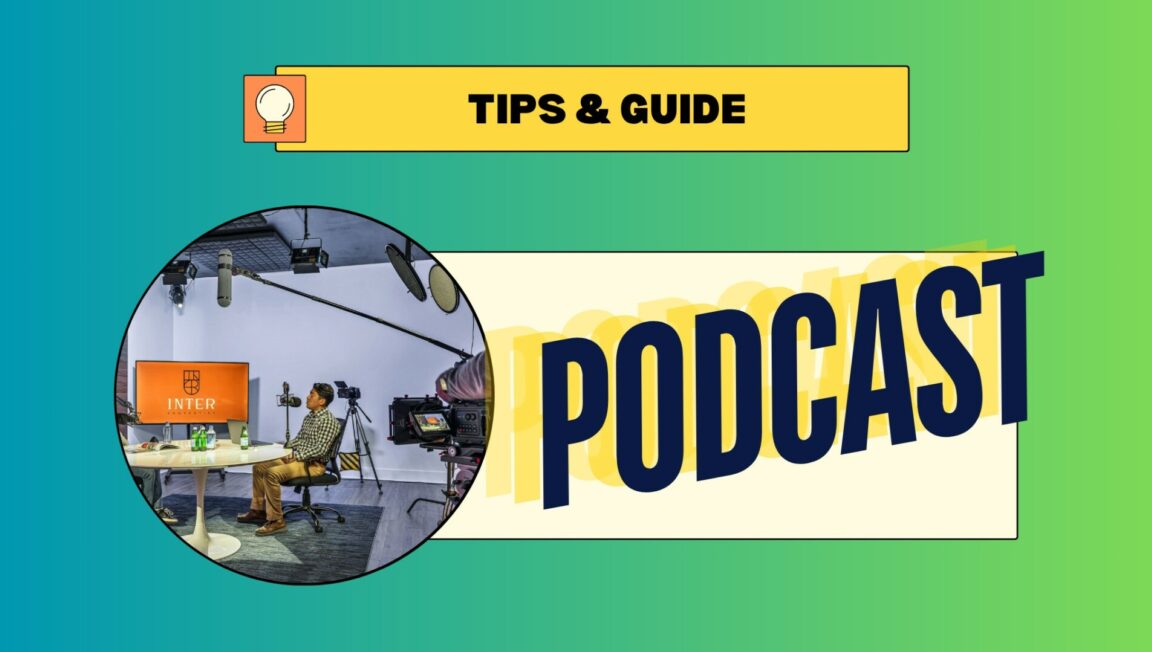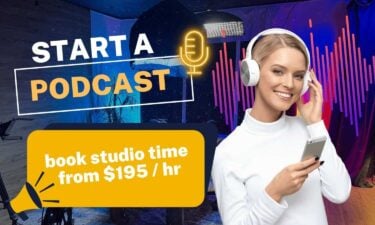Podcasting has exploded in popularity, offering a unique opportunity for individuals and businesses to share their message with the world. But do you know what it takes to create a professional podcast that keeps your listeners engaged and coming back for more? In this ultimate guide, we’ll walk you through every step of the podcast studio production process, from understanding the types of studios and their essential components to planning, setting up, editing, and promoting your podcast. Get ready to transform your podcasting dream into a reality!
Short Summary
- Create captivating audio and video content with the perfect podcast studio setup.
- Plan, design & equip your studio to ensure high-quality audio production.
- Promote & network your podcast for growth through social media marketing & collaboration!
Understanding Podcast Studios
Imagine having a dedicated space for recording and producing your podcast, equipped with everything you need to create engaging content that captivates your audience. That’s the exciting concept of podcast studios! These versatile spaces not only serve as the foundation for amazing podcasts, but can also be utilized for various video production processes, including website videos, brand videos, marketing videos, social media videos, and even television commercials. Additionally, they can be a great asset for film production projects and executing your video project seamlessly.
With the right planning and equipment, your podcast studio can become the launchpad for your audio and video content success, as well as an effective platform for video distribution and implementing a solid video strategy.
Types of Podcast Studios
When it comes to setting up your podcast studio, you have several fantastic options to choose from, each with its unique features and capabilities. Home recording studios are perfect for individual podcasters looking to create professional-sounding content without breaking the bank. With minimal equipment and cost, you can transform a spare room or corner of your home into a productive podcasting space.
If you’re looking for a more sophisticated setup, professional podcast studios offer multiple microphones and seating for live recordings and conversations. These studios allow you to capture high-quality audio and even produce finished videos with video equipment like a video camera for marketing purposes.
Lastly, portable podcast studios give you the freedom to record and produce your podcast on the go. With minimal setup and equipment, you can take your work anywhere and create captivating content in any location.
Essential Components of a Podcast Studio
To create a successful podcast, you’ll need the right equipment and accessories. The must-have components of a podcast studio include a microphone, audio interface, mic stand, pop filters/windscreens, shock mount, headphones, and audio recording software. A high-quality microphone is essential for capturing crystal-clear audio that engages your listeners. The audio interface connects your microphone and other audio equipment to your computer, ensuring a professional-quality recording.
Additionally, a mic stand, pop filters/windscreens, and a shock mount help reduce unwanted noises and vibrations, further enhancing the sound quality of your podcast. Don’t forget the headphones! These play a crucial role in ensuring clear audio monitoring during the recording process.
Lastly, audio recording software is vital for capturing and refining your podcast’s audio, allowing you to create a polished final product.
Planning and Designing Your Podcast Studio
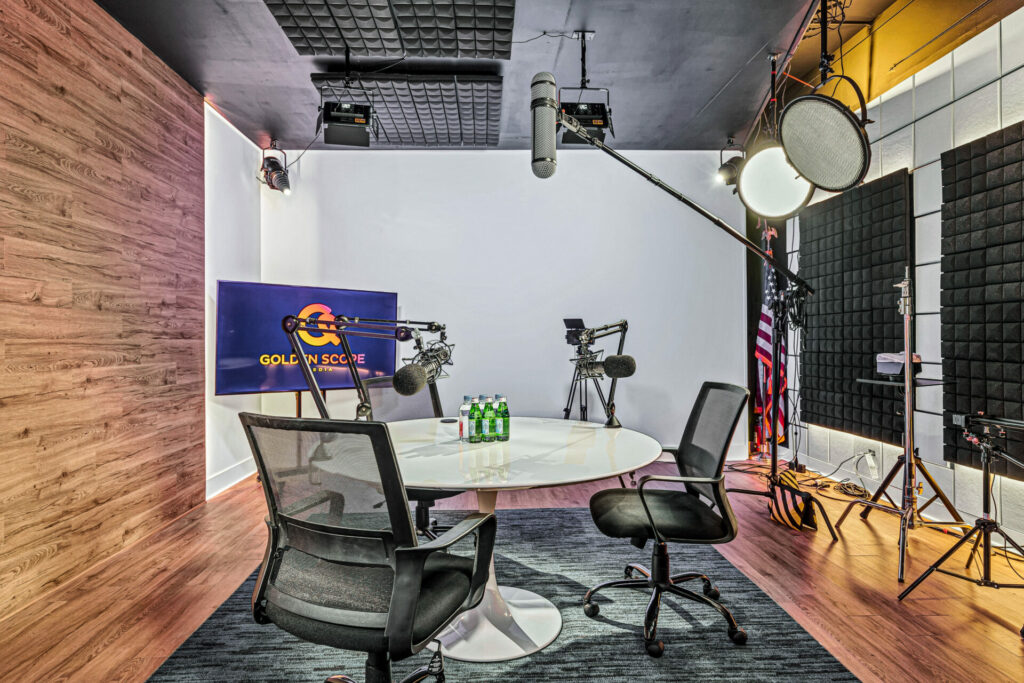
Before diving into the world of podcasting, it’s essential to plan and design your podcast studio to meet your specific needs and goals. This includes assessing your objectives, selecting the right space, and designing for optimal acoustics.
By taking the time to plan and design your studio, you’ll set yourself up for success, ensuring a smooth recording experience and the best possible audio quality for your podcast.
Assessing Your Needs and Goals
Before you can create your dream podcast studio, you need to assess your needs and goals. Start by defining the type of podcast you want to create, the size of your studio, the equipment you’ll need, and the budget you have available. This will help you make informed decisions about the space and equipment required for your podcast. Additionally, consider your target audience and the topics you plan to cover, ensuring that your podcast will resonate with your listeners and provide value to their lives.
The format of your podcast is another crucial aspect to consider. Will it be an interview-style show, a narrative podcast, or a solo commentary? This decision will impact the equipment and space needed for your podcast studio. By clearly understanding your needs and goals, you’ll be better prepared to make the right choices for your podcast’s success.
Choosing the Right Space
When selecting the perfect space for your podcast studio, keep in mind the size, location, and noise levels of the space. The size of the space will determine how many guests you can accommodate and how much equipment you can use to create high-quality audio. The location of your podcast studio will significantly impact the amount of background noise you’ll need to manage and the ease of access for any guests you may have.
Noise levels play a crucial role in the quality of your podcast recordings, so it’s important to consider how much background noise is present and how much soundproofing is necessary. Look for a space that is spacious enough to fulfill your needs, is in a peaceful location, and has minimal noise levels. If necessary, invest in soundproofing materials to achieve the best audio quality possible.
Designing for Optimal Acoustics
Creating the perfect podcast studio requires attention to detail when it comes to acoustics. Soundproofing and acoustic treatment can significantly improve the sound quality of your podcast by reducing unwanted noise and reverberation. There are various soundproofing and acoustic treatment options available, such as soundproofing materials, acoustic panels, bass traps, and diffusers.
When designing your podcast studio for optimal acoustics, it’s essential to utilize soundproofing materials and strategically place acoustic panels, bass traps, and diffusers to minimize reverberation. Additionally, consider the placement of your microphone and speakers to ensure the best possible sound quality during your recording sessions.
Setting Up Your Podcast Studio
Once you’ve planned and designed your podcast studio, it’s time to set up your equipment and start recording!
In this section, we’ll guide you through selecting the right equipment, installing and configuring your gear, and testing your setup to ensure a smooth and successful podcasting experience.
Selecting the Right Equipment
Choosing the right equipment for your podcast studio is crucial for delivering high-quality audio to your listeners. Consider the essentials such as microphones, headphones, audio interfaces, computers, recording spaces, and accessories like mic stands and pop filters. Each piece of equipment plays a vital role in the overall quality and production of your podcast.
As you select your equipment, consider their compatibility with one another and your specific needs. For example, dynamic, condenser, and ribbon microphones each offer unique benefits, while open-back, closed-back, and in-ear headphones cater to various preferences. USB, Firewire, and Thunderbolt audio interfaces also provide different connection options. By carefully selecting the right equipment, you’ll ensure your podcast studio is well-equipped for success.
Installing and Configuring Your Gear
After selecting the perfect equipment for your podcast studio, it’s time to install and configure your gear. Begin by unpacking and inspecting your equipment for any damage or missing parts, ensuring you have everything you need to get started. Power up your gear using the appropriate cables and adapters, and then connect your equipment using the correct cables and adapters as well.
Once your equipment is properly connected, it’s essential to configure your gear for optimal performance. This may include setting the appropriate input and output levels on your audio interface, adjusting microphone settings, and configuring your recording software. By taking the time to properly install and configure your gear, you’ll ensure a smooth recording experience and the highest quality audio for your podcast.
Testing and Troubleshooting
Before hitting the record button, it’s essential to test your podcast studio setup and troubleshoot any issues that may arise. Start by assessing the quality of your recording, ensuring that your audio is clear and free of unwanted noises or interference. Additionally, evaluate your recording environment, checking for any potential acoustic issues that may require further soundproofing or treatment.
If you encounter any issues during testing, take the time to address them promptly. This may involve adjusting the settings on your equipment, reconfiguring your recording space, or seeking assistance from experienced podcasters or audio professionals. By thoroughly testing and troubleshooting your podcast studio setup, you’ll ensure a smooth and enjoyable recording experience for both you and your guests.
Producing and Editing Your Podcast
With your podcast studio set up and your equipment configured, it’s time to dive into the world of podcast production and editing. In this section, we’ll explore effective recording techniques, best practices, and post-production processes to help you create a polished, professional-sounding podcast that will captivate your listeners and keep them coming back for more.
From setting up your microphone to mastering your audio, we’ll cover all the basics.
Recording Techniques and Best Practices
Capturing high-quality audio is the key to creating an engaging podcast. When recording, focus on using the right microphone technique, ensuring that your voice is clear and free of unwanted noises or distortions. Experiment with different microphone positions and distances to find the ideal setup for your voice and recording environment.
In addition to proper microphone technique, it’s also essential to consider the overall recording environment. Ensure your recording space is free of background noise and distractions that could disrupt the flow of your podcast. By following these recording techniques and best practices, you’ll be well on your way to producing a podcast that sounds great and keeps your listeners engaged.
Editing and Post-Production
In the pre production stage, it’s essential to plan and prepare for a successful podcast. A crucial part of this planning is the pre production process, which sets the foundation for editing and post-production. Post-production plays a significant role in crafting a professional-sounding podcast that captivates your audience. It typically involves applying computer editing and graphics skills, which may include adding music, graphics, titles, visual effects, and color correction to your podcast. By meticulously editing your podcast, you can transform your raw audio into a polished final product that resonates with your listeners. In this process, a post production post can serve as a valuable resource for tips, tricks, and best practices.
During the production phase, specifically the video editing process, it’s essential to review and refine your podcast to ensure that every scene and planned detail is included in the final edit. This may involve cutting segments, rearranging content, or adding transitions to create a seamless listening experience. Understanding the video production process can greatly enhance the quality of your final product.
Once your podcast has been edited and refined, you’re ready to export and share it with the world!
Exporting and Publishing Your Podcast
After completing the editing process, it’s time to export and publish your podcast. Use a digital audio workstation (DAW) such as Pro Tools, Logic Pro, or Audacity to export your podcast in an MP3 file format with a bitrate of 128 kbps for the best sound quality.
Once your podcast is ready, publish it on popular podcast platforms like Apple Podcasts, Spotify, Google Podcasts, and Stitcher to maximize your reach and engagement. Utilize a podcast hosting service such as Libsyn, Buzzsprout, or Simplecast to submit your podcast to these platforms and ensure a seamless distribution process.
With your podcast published and available for the world to hear, it’s time to focus on growing and promoting your show.
Growing and Promoting Your Podcast
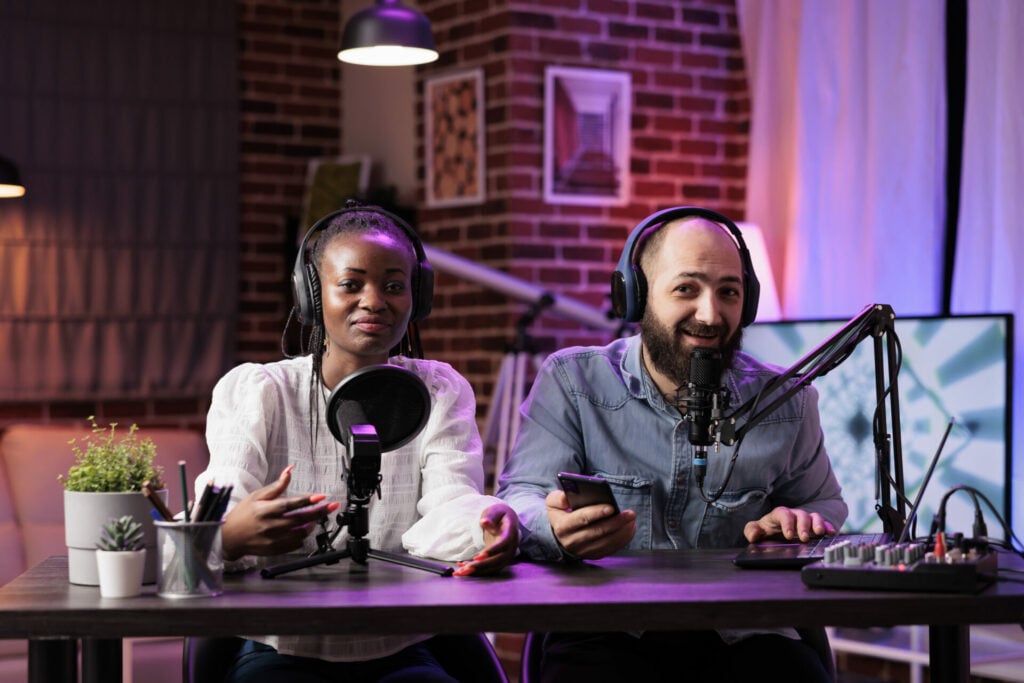
Creating an amazing podcast is just the beginning. To truly reach your target audience and grow your listener base, it’s essential to invest time and effort into promoting your podcast.
In this section, we’ll explore various strategies for marketing your podcast, networking with other podcasters, and measuring your success to ensure continuous growth and improvement.
Social Media Marketing
Social media platforms offer an excellent opportunity to promote your podcast and engage with your audience. Share your podcast episodes on platforms like Twitter, Facebook, and Instagram, and consider creating short video clips or quote graphics to accompany your posts. This not only helps to increase your podcast’s visibility, but also encourages your audience to interact with your content.
To further enhance your social media presence, respond to comments, like posts, and create polls and surveys to gather valuable feedback from your listeners. By actively engaging with your audience on social media, you’ll build a loyal following and foster a sense of community around your podcast.
Networking and Collaboration
Connecting with other podcasters and industry professionals is a fantastic way to expand your reach and create amazing opportunities for your podcast. Attend industry events, join online communities, and collaborate with other podcasters to share knowledge, resources, and insights.
By networking and collaborating with others in the podcasting community, you’ll not only grow your listener base, but also uncover potential partnerships and projects that can elevate your podcast to new heights. Embrace the power of networking and collaboration and watch your podcast soar!
Measuring Success and Analytics
To ensure continuous growth and improvement, it’s crucial to track your podcast’s performance using analytics tools. Monitor watch times, click-through rates, and other key metrics to measure the success of your podcast and identify areas for improvement.
By regularly analyzing your podcast’s performance and making data-driven decisions, you can fine-tune your content and marketing strategies to better resonate with your target audience and achieve your goals. Remember, success is a journey, not a destination – so keep learning, improving, and growing your podcast.
Summary
In this ultimate guide, we’ve explored every aspect of the podcast studio production process, from understanding podcast studios and planning your space to editing, promoting, and growing your podcast. By following these steps and implementing the strategies we’ve discussed, you’ll be well on your way to creating a professional, engaging, and successful podcast that captivates your audience and keeps them coming back for more. So go forth, create, and let your voice be heard!
Frequently Asked Questions

What does a podcast studio do?
A podcast studio provides an ideal environment to record audio files with the help of studio-quality mics and headphones, so that you can bring your own laptop and recording software to create professional sounding podcasts.
With the right setup, you can create high-quality audio recordings that will make your podcast stand out from the rest. You can also use the studio to edit and mix your audio files, giving you the ability to create a professional sounding podcast.
Do I need a studio for a podcast?
You don’t necessarily need a studio for podcasting; you can find a suitable space in your house.
Look for spaces with plenty of soft furnishings to absorb sound.
How do I make a podcast studio?
Creating a great podcast studio involves choosing the right space, soundproofing, gathering the necessary recording equipment, picking an editing software, and selecting a hosting service. Additionally, it’s important to make a list of what’s needed, get the right microphone and audio interface, optimize the room for recording, get the necessary accessories, and select the right software and hosting service for the RSS feed.
What are the essential components of a podcast studio?
A podcast studio requires a microphone, audio interface, mic stand, pop filters/windscreens, shock mount, headphones and audio recording software to create professional-quality recordings.
Having the right equipment is essential for creating high-quality recordings. A microphone is the most important piece of equipment, as it captures the sound that will be recorded. An audio interface is also necessary, as it connects the microphone to the computer and allows for the recording.
How can I choose the right space for my podcast studio?
Choosing the right space for your podcast studio requires careful consideration of size, location, and noise levels.
Get creative and pick the best spot that meets all of your needs!
readers also enjoyed…
keep the momentum going.
explore more blogs and industry news
